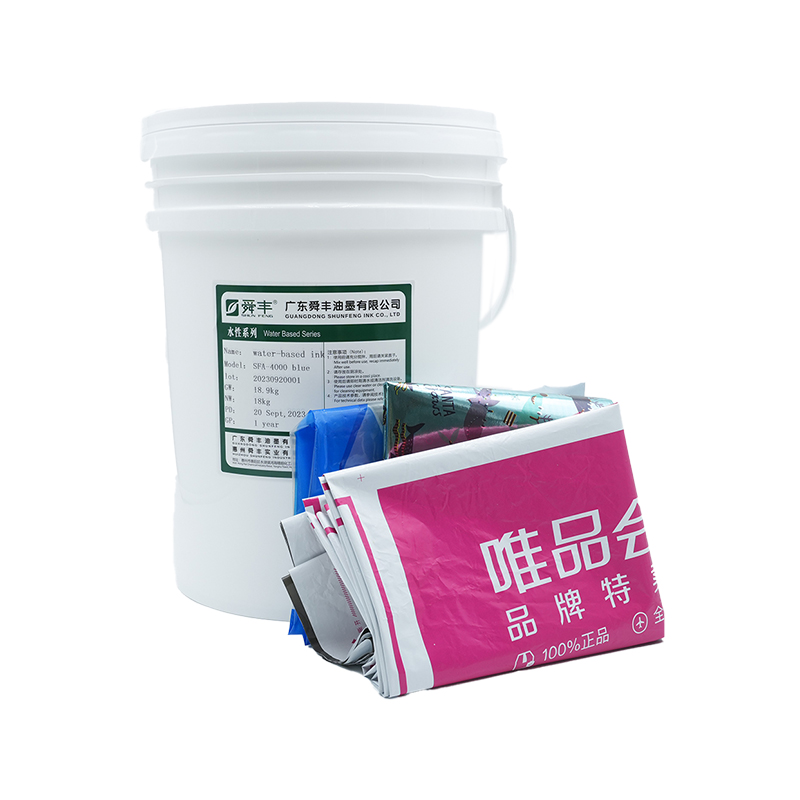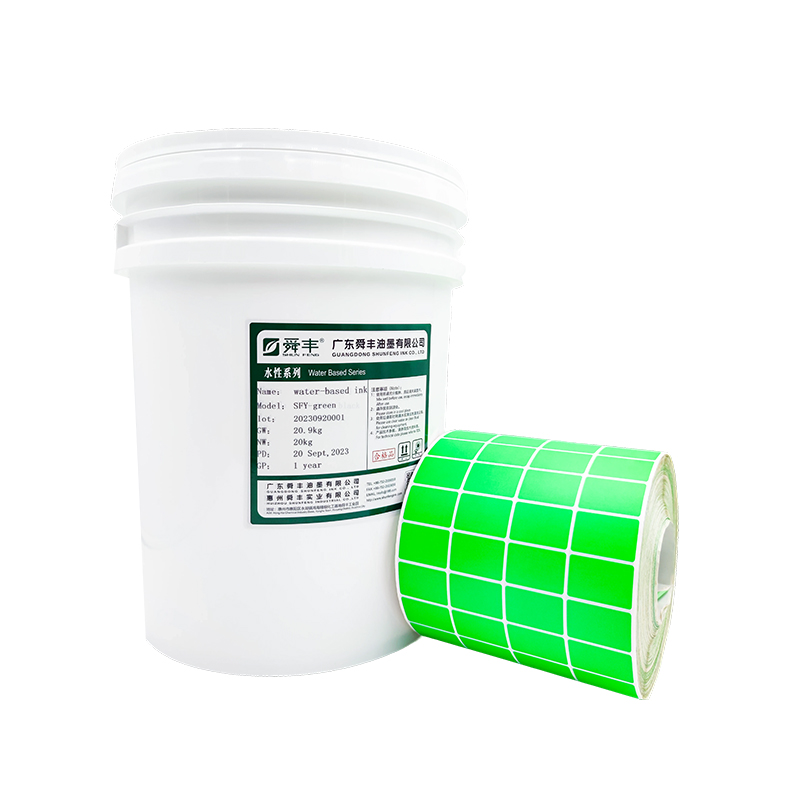How does Flexo water-based fluorescent ink maintain excellent rheological properties to ensure accurate color reproduction?
Release Time : 2025-10-22
In modern packaging printing, the pre-printing process for corrugated boxes has become a mainstream technology for mid- to high-end carton packaging due to its high print quality, high production efficiency, and excellent post-processing adaptability. During the pre-printing process, Flexo water-based fluorescent ink is a key material, and its properties directly impact the final print quality. Rheological properties—the ink's flow and deformation characteristics under shear—are key factors in determining ink transfer uniformity, dot reproduction, and color consistency.
1. The Definition of Rheological Properties and Their Impact on Print Quality
Rheological properties primarily include ink viscosity, thixotropy, yield value, and shear-thinning properties. In the flexographic printing process, ink is transferred from the ink fountain via the anilox roller to the flexographic printing plate, and then to the paper surface. This process involves flow behavior at different shear rates: at low shear rates, the ink must maintain a certain viscosity and structural strength to prevent sedimentation and runniness; at high shear rates, the ink must thin rapidly for easy and even transfer, avoiding ink splashing and plate clogging. If rheological properties are unstable, the ink may experience viscosity fluctuations, poor flow, or uneven transfer, leading to color shift, dot gain, blurred edges, and other issues, seriously impacting accurate color reproduction.
2. Scientific Formula Design: The Foundation for Stable Rheological Properties
The rheological properties of Flexo water-based fluorescent inks depend primarily on their formulation design. High-quality water-based inks utilize high-molecular-weight synthetic resins as binders. These resins not only provide excellent film-forming properties and adhesion, but also manipulate the ink's rheological behavior through their molecular chain structure. For example, the addition of specific rheological additives can form a three-dimensional network within the ink, imparting excellent thixotropy and shear-thinning properties—high viscosity at rest, preventing pigment sedimentation, and rapid viscosity drop upon shear, facilitating uniform transfer. Pigment dispersion stability is also crucial. High-efficiency dispersants and milling processes ensure uniform distribution of pigment particles, preventing agglomeration that would increase viscosity or uneven flow, thereby ensuring color saturation and consistency.
3. pH and Moisture Control: Maintaining a Dynamic Balance
Water-based inks use water as their primary solvent, and their rheological properties are highly susceptible to environmental temperature, humidity, and pH. The pH value is typically maintained between 8.5 and 9.5 to maintain the resin's solubility and the ink's stability. If the pH drops, the resin may precipitate, resulting in increased viscosity and poor fluidity. Conversely, excessive pH may cause foaming or plate corrosion. Therefore, the pH value must be monitored and adjusted during the printing process, typically through the addition of amine buffers. Furthermore, the evaporation rate of water directly affects ink viscosity. Especially at high printing speeds, rapid evaporation from the ink tank can cause the ink to thicken. Modern flexographic printing equipment is often equipped with a closed ink chamber and an automatic viscosity control system. By adding deionized water or a specialized diluent, the ink concentration can be dynamically adjusted to ensure optimal rheological properties.
4. Synergistic Optimization with Printing Equipment
The rheological properties of the ink must also be matched to the parameters of the printing equipment. The line count, cell volume, and squeegee angle of the anilox roller directly affect the ink transfer rate and shear rate. High-line count anilox rollers require lower ink viscosity and better fluidity to ensure adequate cell filling and clean squeegeeing. By adjusting the ink's yield value and thixotropy, it remains stable under low shear conditions and flows rapidly under high shear, perfectly adapting to varying printing speeds and image types, achieving precise reproduction of everything from fine text to large solid areas.
Flexo water-based fluorescent ink achieves excellent rheological properties through a scientific resin and additive formulation, stable pH and moisture control, and optimized integration with printing equipment. This stable flow behavior ensures uniform ink transfer, crisp dots, and rich colors even at high printing speeds, resulting in highly accurate color reproduction.
1. The Definition of Rheological Properties and Their Impact on Print Quality
Rheological properties primarily include ink viscosity, thixotropy, yield value, and shear-thinning properties. In the flexographic printing process, ink is transferred from the ink fountain via the anilox roller to the flexographic printing plate, and then to the paper surface. This process involves flow behavior at different shear rates: at low shear rates, the ink must maintain a certain viscosity and structural strength to prevent sedimentation and runniness; at high shear rates, the ink must thin rapidly for easy and even transfer, avoiding ink splashing and plate clogging. If rheological properties are unstable, the ink may experience viscosity fluctuations, poor flow, or uneven transfer, leading to color shift, dot gain, blurred edges, and other issues, seriously impacting accurate color reproduction.
2. Scientific Formula Design: The Foundation for Stable Rheological Properties
The rheological properties of Flexo water-based fluorescent inks depend primarily on their formulation design. High-quality water-based inks utilize high-molecular-weight synthetic resins as binders. These resins not only provide excellent film-forming properties and adhesion, but also manipulate the ink's rheological behavior through their molecular chain structure. For example, the addition of specific rheological additives can form a three-dimensional network within the ink, imparting excellent thixotropy and shear-thinning properties—high viscosity at rest, preventing pigment sedimentation, and rapid viscosity drop upon shear, facilitating uniform transfer. Pigment dispersion stability is also crucial. High-efficiency dispersants and milling processes ensure uniform distribution of pigment particles, preventing agglomeration that would increase viscosity or uneven flow, thereby ensuring color saturation and consistency.
3. pH and Moisture Control: Maintaining a Dynamic Balance
Water-based inks use water as their primary solvent, and their rheological properties are highly susceptible to environmental temperature, humidity, and pH. The pH value is typically maintained between 8.5 and 9.5 to maintain the resin's solubility and the ink's stability. If the pH drops, the resin may precipitate, resulting in increased viscosity and poor fluidity. Conversely, excessive pH may cause foaming or plate corrosion. Therefore, the pH value must be monitored and adjusted during the printing process, typically through the addition of amine buffers. Furthermore, the evaporation rate of water directly affects ink viscosity. Especially at high printing speeds, rapid evaporation from the ink tank can cause the ink to thicken. Modern flexographic printing equipment is often equipped with a closed ink chamber and an automatic viscosity control system. By adding deionized water or a specialized diluent, the ink concentration can be dynamically adjusted to ensure optimal rheological properties.
4. Synergistic Optimization with Printing Equipment
The rheological properties of the ink must also be matched to the parameters of the printing equipment. The line count, cell volume, and squeegee angle of the anilox roller directly affect the ink transfer rate and shear rate. High-line count anilox rollers require lower ink viscosity and better fluidity to ensure adequate cell filling and clean squeegeeing. By adjusting the ink's yield value and thixotropy, it remains stable under low shear conditions and flows rapidly under high shear, perfectly adapting to varying printing speeds and image types, achieving precise reproduction of everything from fine text to large solid areas.
Flexo water-based fluorescent ink achieves excellent rheological properties through a scientific resin and additive formulation, stable pH and moisture control, and optimized integration with printing equipment. This stable flow behavior ensures uniform ink transfer, crisp dots, and rich colors even at high printing speeds, resulting in highly accurate color reproduction.







